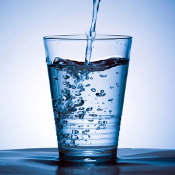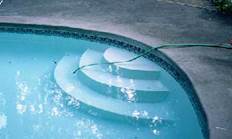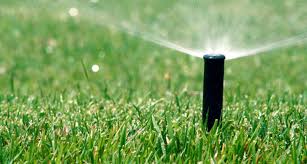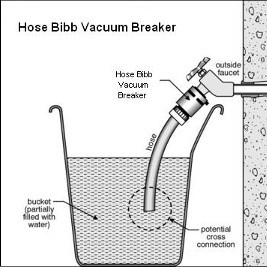The City of Wyoming is committed to protecting our drinking water system from contamination. One of the ways that contamination can get into the water system is through a cross connection. A cross connection can be an actual or potential connection between a drinking water supply and a source of contamination.
How can a cross connection occur?
 For example, a drinking water line may enter an industrial facility and be piped to a chemical rinse tank. If a water flow reversal were to occur (due to a water line break outside, a fire next door, or similar), the chemicals in the rinse tank could be sucked into the drinking water system. This type of event is called backsiphonage. If the chemical rinse tank was pressurized at a higher pressure than the drinking water system, the chemicals could be forced into the drinking water system. This type of event is called backpressure.
For example, a drinking water line may enter an industrial facility and be piped to a chemical rinse tank. If a water flow reversal were to occur (due to a water line break outside, a fire next door, or similar), the chemicals in the rinse tank could be sucked into the drinking water system. This type of event is called backsiphonage. If the chemical rinse tank was pressurized at a higher pressure than the drinking water system, the chemicals could be forced into the drinking water system. This type of event is called backpressure.
 Or suppose you are filing a pool with a garden hose, and the hose is submerged in the pool. If there were to be a water line break down the street causing a loss in pressure, the contents of the pool could be 'vacuumed' back into the water supply. This is another example of backsiphonage.
Or suppose you are filing a pool with a garden hose, and the hose is submerged in the pool. If there were to be a water line break down the street causing a loss in pressure, the contents of the pool could be 'vacuumed' back into the water supply. This is another example of backsiphonage.
How do we prevent this?
Cross connections are prevented through either a physical separation or use of a backflow preventer. Physical separation means that there is a gap of air between the source of contamination and the water supply. In the swimming pool example, simply moving the hose so that it fills the pool from above the water line would prevent a backflow event.
A backflow preventer could be used to ensure that a cross connection does not occur from the chemical rinse tank example. This mechanical device, if properly installed and maintained, is designed to prevent contaminated water from entering the drinking water supply. There are many different types of backflow devices that can have different applications depending on the situation.
What are the requirements for testing backflow devices?
All testable backflow devices must be tested at set frequencies by a state certified tester, notifications will be sent when the device tests are due. A tester must submit device test data to the City of Wyoming through our web portal: Submit Results. No test forms will be accepted through email, mail, or fax.
Certified testers will receive login credentials for the web portal once Wyoming has received documentation for tester certification and the annual accuracy certification for the tester's test gauge. For more information, please see our Online Submittal Instructions.
What are some other examples of cross connections?
Residential Examples
- Hoses submerged in dirty buckets
- Lawn irrigation systems
- Water softeners
- Fire sprinkler systems
- Water-assisted sump pumps
- Hot tubs
- Boilers
- Toilet fill valves
Industrial or Commercial
- Lawn irrigation systems
- Fire sprinkler systems
- Cooling towers
- Dishwashers
- Soap dispensers
- Hose connections
- Food processing equipment
- Chemical feed equipment
- Laboratory equipment
- Mop/slop sinks
How is the regulated?
The Michigan Department of Environment, Great Lakes, and Energy (EGLE) requires water utilities to have a cross connection control program. This is defined in Part 14 of the Michigan Safe Drinking Water Act. Additionally, the MDEQ has published a Cross Connection Rules Manual which more fully explains Cross Connection Control Programs. The Michigan Plumbing Code also has requirements regarding preventing cross connections.
How does Wyoming's Cross Connection Program work?
Wyoming has had an EGLE approved cross connection program since 1972. This program is responsible for identifying and eliminating cross connections within the City. To accomplish this, staff inspect facilities, require testing of backflow preventer, and educate the community through mailings and/or public outreach events.
Environmental Services Inspectors conduct the site surveys of all commercial and industrial facilities. These surveys involve looking at all water lines, uses, and backflow devices. Inspectors use a cloud-based software called Formlink Palladium® to track inspections and backflow devices.
All testable backflow devices must be tested annually by a State Certified Tester as required by the Michigan Plumbing Code.
Who are the Certified Testers?
Starting January 1, 2018, an individual must hold the ASSE 5110 certification to perform backflow assembly testing in Michigan. To perform testing and submit data through our web link in Wyoming, one must also registered with the City of Wyoming Cross Connection Department.
As a homeowner, what is my responsibility?
 The most common type of homeowner cross connections are underground sprinkler systems or unprotected hoses. A hose bib vacuum breaker (HBVB) is a type of backflow preventer that is a cheap and easy way to prevent backflow of water through a hose. Special frost-free HBVBs are available for exterior applications.
The most common type of homeowner cross connections are underground sprinkler systems or unprotected hoses. A hose bib vacuum breaker (HBVB) is a type of backflow preventer that is a cheap and easy way to prevent backflow of water through a hose. Special frost-free HBVBs are available for exterior applications.
 You may see us in your neighborhood during the summer months; we are identifying backflow devices at all residential homes in Wyoming. All lawn irrigation systems are required by law to have a backflow prevention device installed. Recent changes to the MI Safe Drinking Water Act Rules now require that all Underground Sprinkling backflow devices installed at your home be tested every five years to verify that they are working properly.
You may see us in your neighborhood during the summer months; we are identifying backflow devices at all residential homes in Wyoming. All lawn irrigation systems are required by law to have a backflow prevention device installed. Recent changes to the MI Safe Drinking Water Act Rules now require that all Underground Sprinkling backflow devices installed at your home be tested every five years to verify that they are working properly.
These tests must be completed by a State Certified Tester and all test results must be submitted through our web portal. A list of registered testing contractors can be found at the link above. We send out residential device testing notifications in May; you will receive a notification when it is time to have your device tested. You are responsible to schedule this test with a contractor and cover the cost for the test and repairs that may be necessary. Please call the CCC department at 616-261-3559 with any questions.
Where can I find other information?
Please contact the Environmental Services Department at 616-261-3559 or by email.